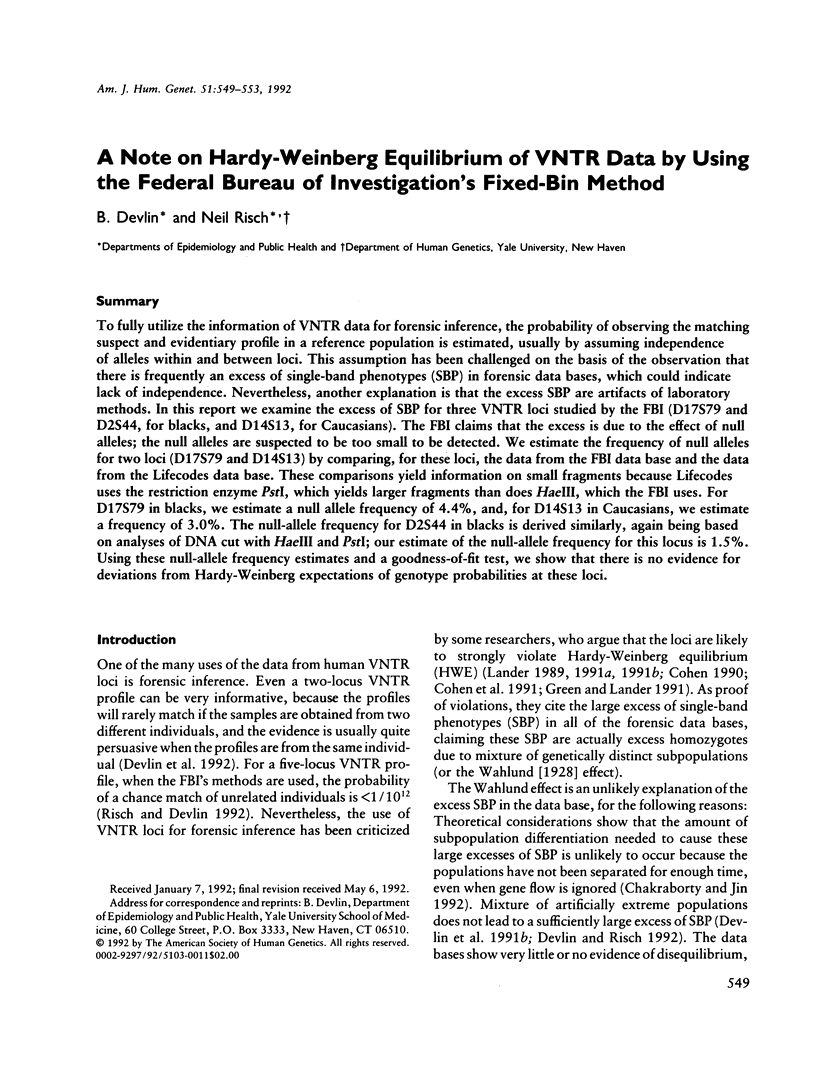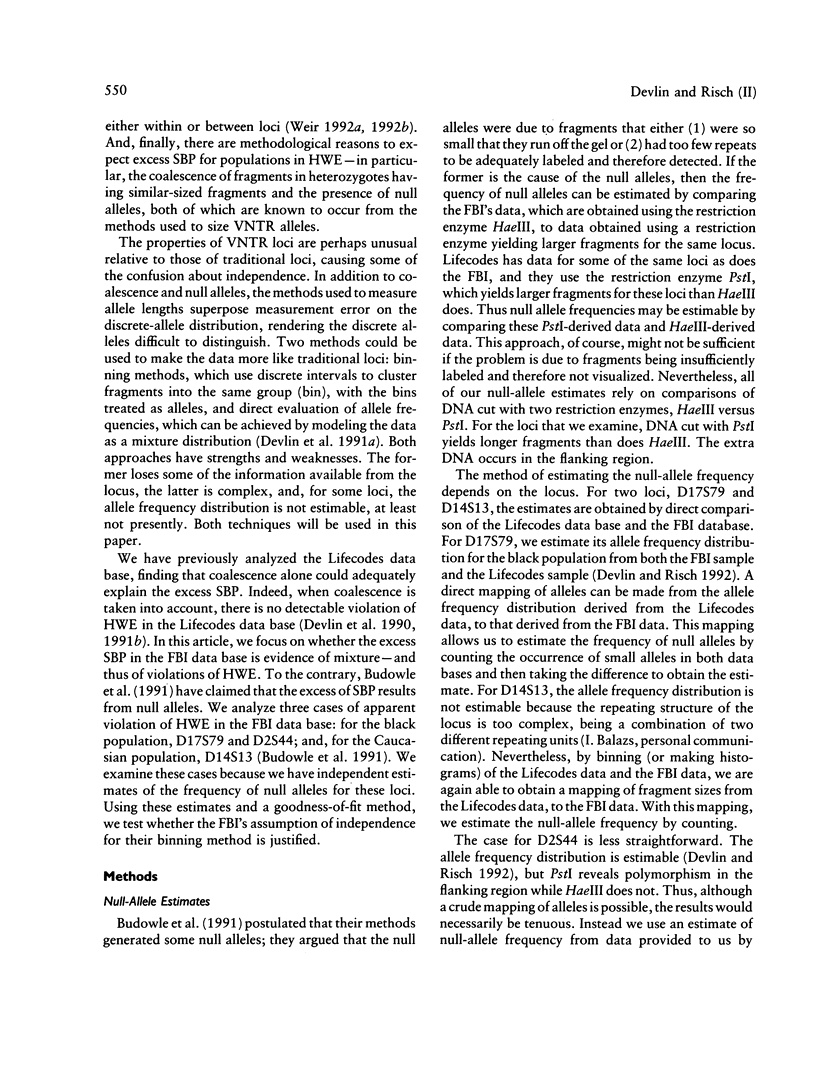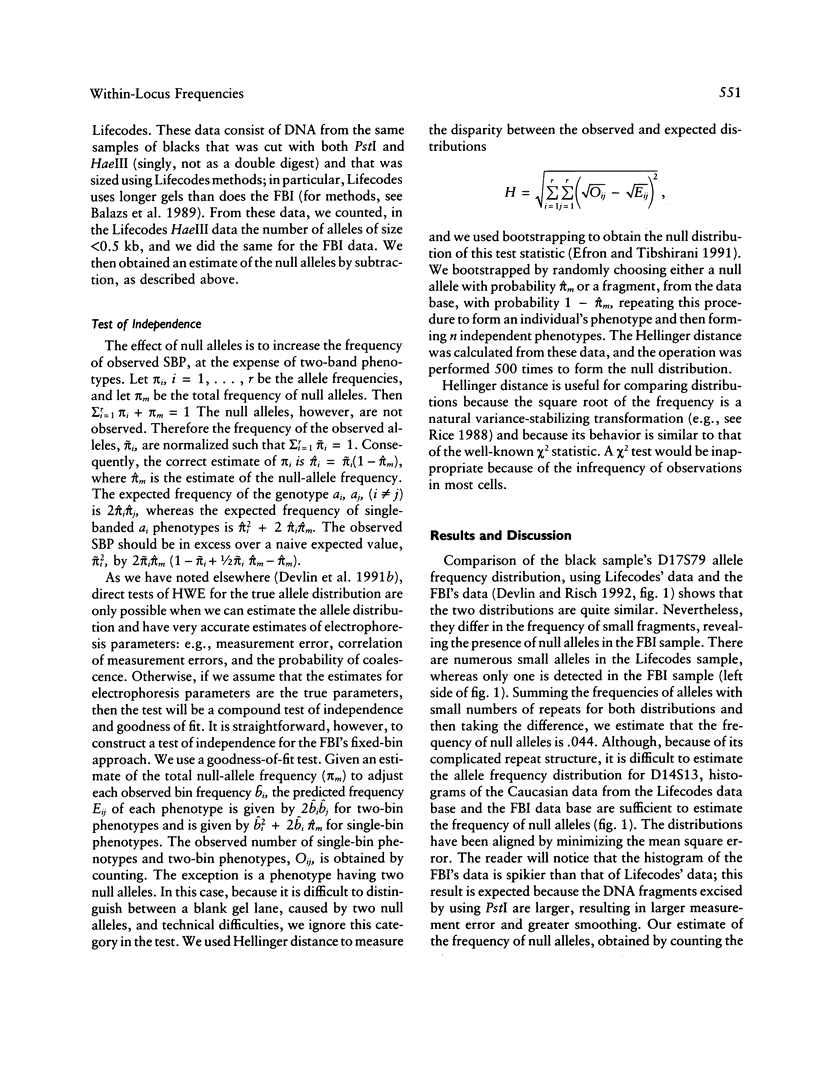Abstract
To fully utilize the information of VNTR data for forensic inference, the probability of observing the matching suspect and evidentiary profile in a reference population is estimated, usually by assuming independence of alleles within and between loci. This assumption has been challenged on the basis of the observation that there is frequently an excess of single-band phenotypes (SBP) in forensic data bases, which could indicate lack of independence. Nevertheless, another explanation is that the excess SBP are artifacts of laboratory methods. In this report we examine the excess of SBP for three VNTR loci studied by the FBI (D17S79 and D2S44, for blacks, and D14S13, for Caucasians). The FBI claims that the excess is due to the effect of null alleles; the null alleles are suspected to be too small to be detected. We estimate the frequency of null alleles for two loci (D17S79 and D14S13) by comparing, for these loci, the data from the FBI data base and the data from the Lifecodes data base. These comparisons yield information on small fragments because Lifecodes uses the restriction enzyme PstI, which yields larger fragments than does HaeIII, which the FBI uses. For D17S79 in blacks, we estimate a null allele frequency of 4.4%, and, for D14S13 in Caucasians, we estimate a frequency of 3.0%. The null-allele frequency for D2S44 in blacks is derived similarly, again being based on analyses of DNA cut with HaeIII and PstI; our estimate of the null-allele frequency for this locus is 1.5%.(ABSTRACT TRUNCATED AT 250 WORDS)
Full text
PDF




Selected References
These references are in PubMed. This may not be the complete list of references from this article.
- Balazs I., Baird M., Clyne M., Meade E. Human population genetic studies of five hypervariable DNA loci. Am J Hum Genet. 1989 Feb;44(2):182–190. [PMC free article] [PubMed] [Google Scholar]
- Budowle B., Giusti A. M., Waye J. S., Baechtel F. S., Fourney R. M., Adams D. E., Presley L. A., Deadman H. A., Monson K. L. Fixed-bin analysis for statistical evaluation of continuous distributions of allelic data from VNTR loci, for use in forensic comparisons. Am J Hum Genet. 1991 May;48(5):841–855. [PMC free article] [PubMed] [Google Scholar]
- Chakraborty R., Jin L. Heterozygote deficiency, population substructure and their implications in DNA fingerprinting. Hum Genet. 1992 Jan;88(3):267–272. doi: 10.1007/BF00197257. [DOI] [PubMed] [Google Scholar]
- Cohen J. E. DNA fingerprinting for forensic identification: potential effects on data interpretation of subpopulation heterogeneity and band number variability. Am J Hum Genet. 1990 Feb;46(2):358–368. [PMC free article] [PubMed] [Google Scholar]
- Devlin B., Risch N. Ethnic differentiation at VNTR loci, with special reference to forensic applications. Am J Hum Genet. 1992 Sep;51(3):534–548. [PMC free article] [PubMed] [Google Scholar]
- Devlin B., Risch N., Roeder K. No excess of homozygosity at loci used for DNA fingerprinting. Science. 1990 Sep 21;249(4975):1416–1420. doi: 10.1126/science.2205919. [DOI] [PubMed] [Google Scholar]
- Efron B., Tibshirani R. Statistical data analysis in the computer age. Science. 1991 Jul 26;253(5018):390–395. doi: 10.1126/science.253.5018.390. [DOI] [PubMed] [Google Scholar]
- Green P., Lander E. S. Forensic DNA tests and hardy-weinberg equilibrium. Science. 1991 Aug 30;253(5023):1038–1039. doi: 10.1126/science.253.5023.1038. [DOI] [PubMed] [Google Scholar]
- Lander E. S. DNA fingerprinting on trial. Nature. 1989 Jun 15;339(6225):501–505. doi: 10.1038/339501a0. [DOI] [PubMed] [Google Scholar]
- Weir B. S. Independence of VNTR alleles defined as fixed bins. Genetics. 1992 Apr;130(4):873–887. doi: 10.1093/genetics/130.4.873. [DOI] [PMC free article] [PubMed] [Google Scholar]


